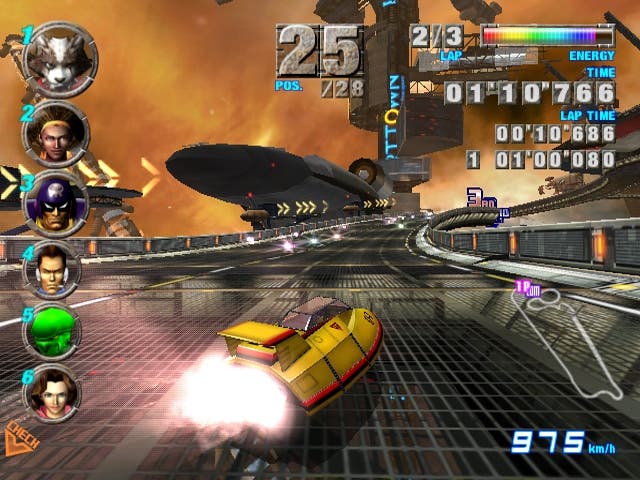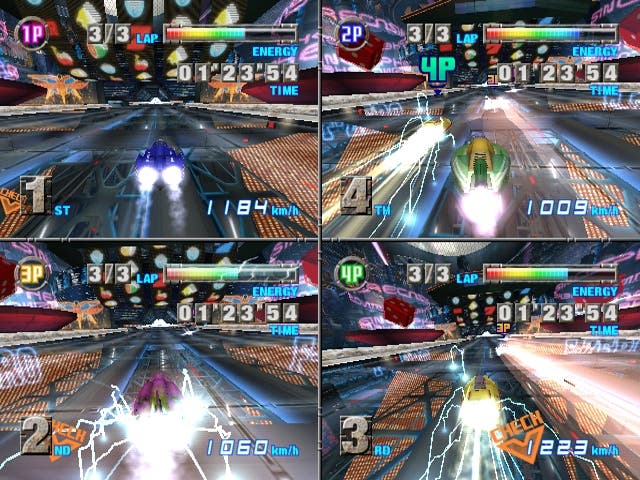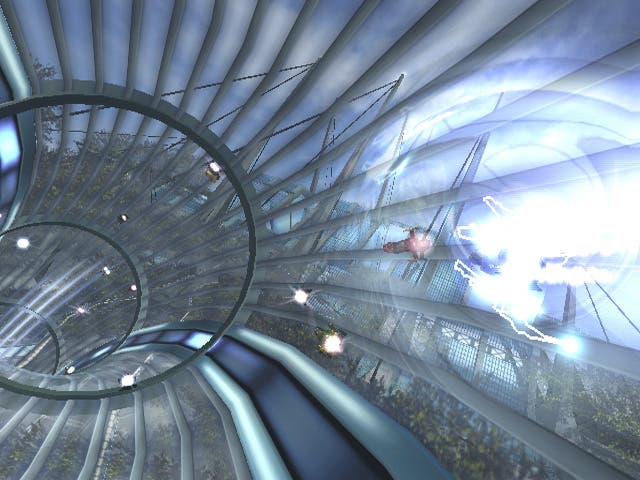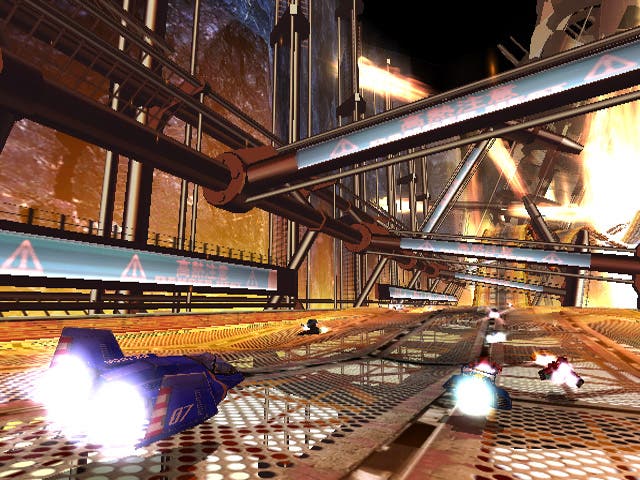F-Zero GX
Tom goes hands-on with the Japanese version of the Sega-developed futuristic racer.
One arcade pod. If we were Nintendo, we would have bought a whole row of the things and plastered slogans like "the fastest and more exhilarating futuristic racer ever conceived" all over E3. And if we were Sega, we'd rehouse Amusement Vision in a palatial gold-plated workshop and mark it "do not disturb" until its next masterpiece is complete. Forget Wipeout - after a few hours with F-Zero GX, designed by the Japanese Monkey Ball geniuses, we certainly have.
Battle Royale

Were we ever sceptical? No, not really. Nintendo's habit of farming out old franchises for GameCube development has proved very successful so far - and by giving them up to new development teams, has opened the door to hitherto unexpected levels of reinvention. Metroid Prime gave Samus a new lease of life, and Namco seems to be doing wonderful things with Star Fox after Rare arguably botched it up on the way to its current business of making the Stamper clan houses out of pure gold, or whatever it's up to these days.
F-Zero GX doesn't aspire to the same level of reinvention as those two. Graphically it's a fantastic progression of course, but what we have here is more like Kinji Fukasaku redirecting the car chase from Bullitt - you know it sounds good, you know it looks good, and you know it feels like a riot, you just wish you could put your finger on exactly why it's so much better than it was.
It's got everything you could want, starting with an enhanced version of the Monkey Ball engine, with that same flawlessly smooth aesthetic as its simian sibling, gliding along at a lightning 60 frames per second throughout. It's packed with beautiful background effects like giant worms arching over the desert tracks, breathtaking weather effects and dazzling ignition and boost effects on every handsome racer, each of them visually molested by weapons damage and barrier contact at regular intervals, and appreciably beefed with every subsequent addition of custom parts.
X marks the spot

The vehicles have made their way happily over from F-Zero X - bound to their original performance characteristics - along with 10 from the AX version of this iteration, although you only get four (Falcon, Goroh, Pico and Stewart) to begin with. The others are all waiting to be unlocked by tickets earned in the various game modes, which can also be employed in the brand new Customisation mode.
Customisation is one of GX's biggest draws, and we only wish we understood more Japanese so that we could really get to the bottom of it [where's Rob when you need him? - Ed]. A layman's overview of it seems to be that you can build new vehicles out of hundreds of combinations of bolt-on parts, each contributing one aspect to a grade system. By picking and choosing carefully from the various body, engine and cockpit bolt-ons at the shop, you can build a racer that strikes a perfect balance between cornering, body, boost and acceleration statistics, then take your new speed demon through any aspect of the game.
Creating a balanced racer is no mean feat (particularly when you're doing so against a language barrier), but it's obvious that you have to take into account things like the weight of the car affecting acceleration - it's no use building a racer that tops out at 2000kph, soaks up more damage than a nuclear testing facility without batting an eyelid, and corners like an Apache Longbow, if it takes 14 seconds to shift half an inch off the line. Once you get the hang of it though, this should prolong your enjoyment of GX no end, particularly as you can smear your handiwork with custom logos designed using a pretty decent paint tool to give your accomplishments a signature aesthetic.
What's the story?

And there is much to stamp your authority upon, and it won't be easy. The familiar Grand Prix mode throws up various contestable trophies, with Ruby, Sapphire and Emerald cups to be fought over at the start. There's no Death Race option to complement it in GX, but then there are 30 racers on every track, so we can get over that. It's a shame you can't go for a multiplayer GP, but the VS Battle mode is sufficiently entertaining - and although it sacrifices the extraneous off-track detail, it does so in order to retain that wondrously smooth frame rate.
Like Customisation, Story Mode is a new addition, padding out a series of increasingly WaveBird-breaking challenges with cheesy FMV sequences (although, honestly, nothing in GX is as hilariously cheesy as the Japlish racer "interviews" at the end of a Grand Prix) and this is likely to hold your attention for tens of hours as you run each of the game's gauntlets. Like a series of futuristic Gran Turismo license tests, these automotive battles require dedication and practice to complete, whether it's collecting icons scattered around the track and completing three laps within 60 seconds, or beating a particular rival through a boulder-strewn canyon (Anakin would be proud), and you can buy more and more challenges as you progress through them.
Further to Story/Grand Prix and VS Battle, there are of course Time Trial and Practice modes. It's an old cliché, we must confess, but it's genuinely true that Time Trial brings out the best in both the racer and the tracks, and will dominate speed demons for months after the rest of the game is thoroughly clocked.
The Fast and the Furious

Truly, the tracks we've seen so far are works of genius. The opening few don't offer much resistance, but then the game throws in twists, turns and jumps, rolls back on itself, corkscrews all over the place and scatters boost pads around in awkward places. In some sections, it even separates recharge pads and boost sections, so you're forced to consider the need for speed and the relative need for repair as you clamour for podium positions.
The tracks actually remind us more of the SNES F-Zero than the N64's inferior X version, and but they're a lot wider than we're used to on the whole. Fortunately, this is made up for with the addition of a lot more racers, and decent, competitive and not too cheaty AI pilots - and it's plain to see that each and every circuit is built on an intricate knowledge of what made F-Zero/X great to begin with. Given Amusement Vision's attention to hardcore detail in Monkey Ball, it will come as little surprise to discover subtle nuances throughout the game, and conscientiously constructed tracks that don't reveal their full potential until you're zooming around them in a top car for the sixtieth consecutive time trial lap.
This is something you will need to do, because F-Zero GX is a surprisingly hard game. Maybe we've been spoilt by overly easy modern racers, but GX feels pretty hardcore, and we've yet to really make our mark on the Master difficulty level. Anyone used to breezing through championships the first or second time isn't going to enjoy vying for the real prizes to start off with, but the practice is well worth the pay-off in our view.
Old and New

At this stage, those of you with any experience in an F-Zero racer are probably chomping at the bit in anticipation of GX's European release (who are we kidding? It's out in the US soon...fire up Freeloader, chaps), but before you fetch your pre-order hat and break out your long suffering credit card, you'll probably want to hear about the controls and handling. Suffice to say, it's very similar to the N64 version, with A for acceleration, B for standard brakes, L and R for airbrakes (offering increased braking and steering response for hairpins and the like when fully depressed), and Y bound to the familiar boost - which behaves much as it always has done, offering an infusion of high speed at the expense of rechargeable energy.
Attacks are bound to X (side attack) and Z (spin attack), and with so many vehicles on the track they play quite a significant part - a carefully measured side attack can actually send a rival right off the track and into the zero points bracket for that race - so it's a good thing the handling is spot on, allowing you to leave driving to your reactions and strategise a little. As long as you don't take an unexpected leap and have to contend with steering back towards terra firma - floating and diving aren't as pronounced as they were in F-Zero X, but they can still prove vital.
In short then, F-Zero GX handles just as you would expect, with racers turning sharply (or at least as sharply as your own custom stats dictate), rendering the negotiation of right-angled turns and the avoidance of drag strips tricky but fair. It's not too different, and it's not too much the same. It definitely requires relearning, which is the important thing.
Gone in 60 milliseconds
We have a feeling that few will argue that F-Zero GX is tremendous fun, and it's the sort of game that the GameCube desperately needs. Sega's Amusement Vision chaps really knows what it's doing with this series, which retains its incredible sense of speed and feverish excitement. F-Zero X or even just plain old F-Zero fans will embrace the familiar feel and distinctive new challenges, and we honestly can't find much to fault it for after 15 hours' play. That's not to say we won't turn up some issues when we can read the text and work out more of what's going on, but at this stage it's on a collision course with brilliance at 2000kph.
We just can't wait for the US version so we can really appreciate it.

